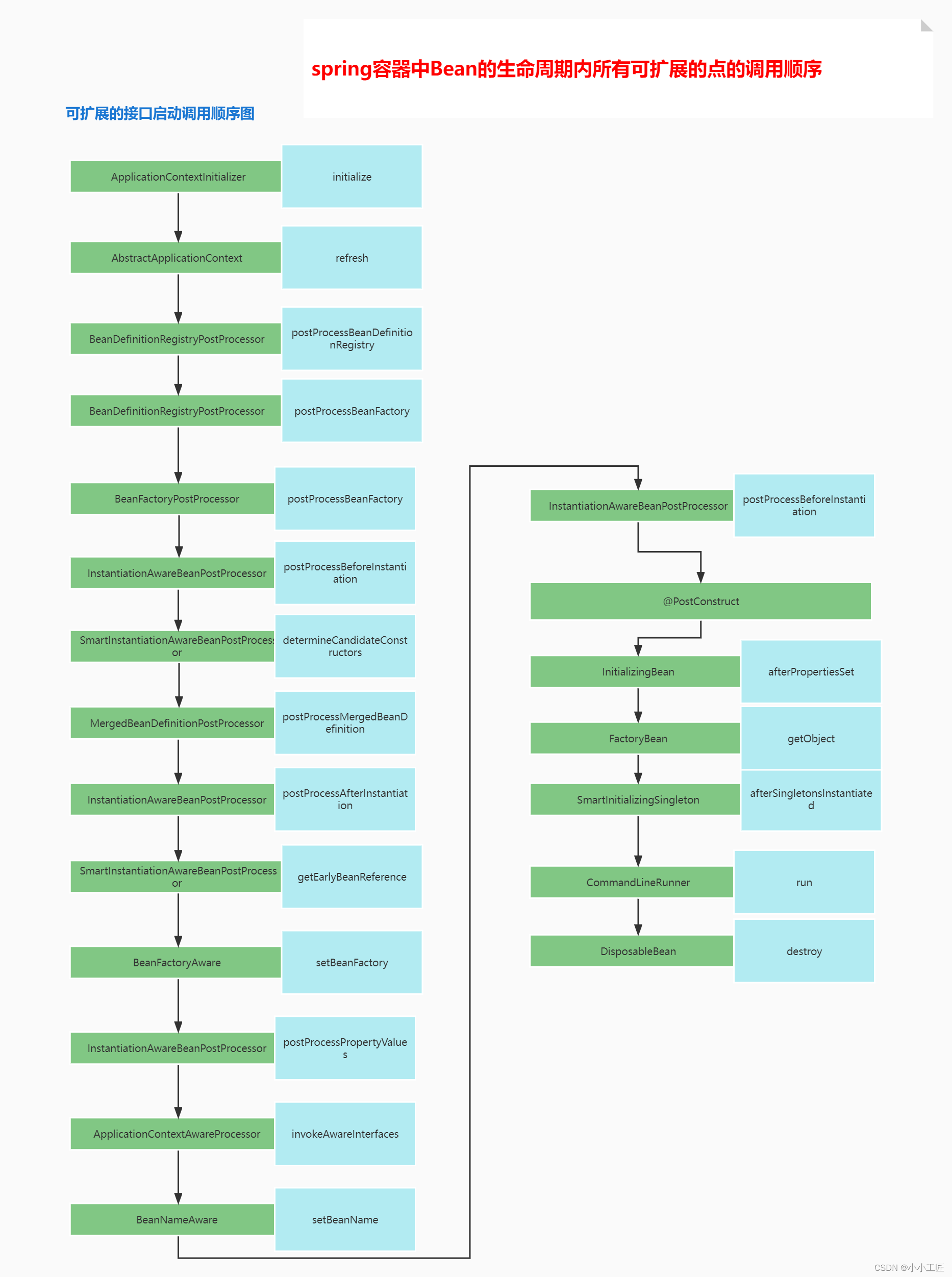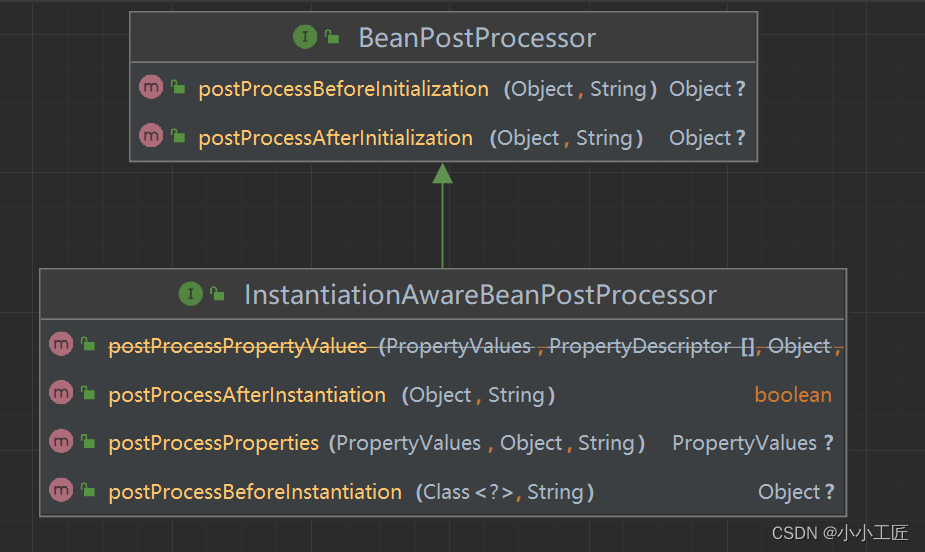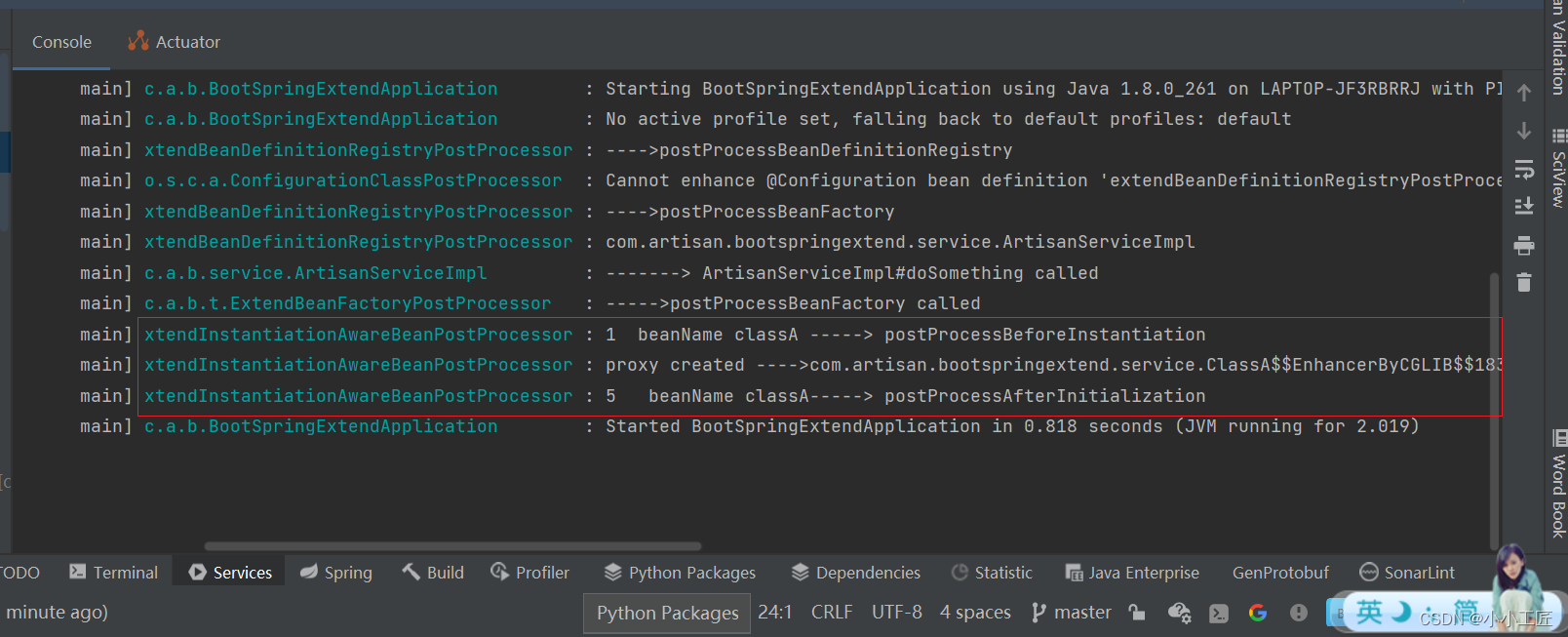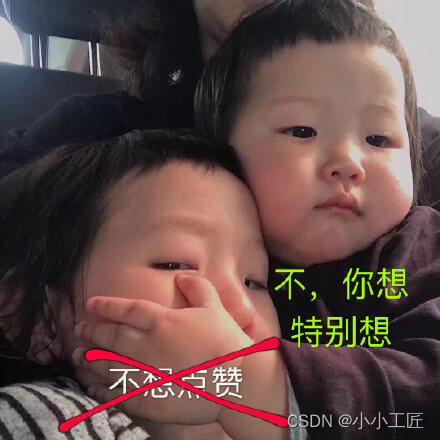-
Spring - InstantiationAwareBeanPostProcessor 扩展接口

Pre

org.springframework.beans.factory.config.InstantiationAwareBeanPostProcessor

注意下: Initialization 表示 初始化 (意思是对象已经生成) 。 Instantiation 表示 实例化 (意思是对象还未生成) 。
接口继承了
BeanPostProcess接口 , 从方法上我们也可以看出InstantiationAwareBeanPostProcessor做了一些扩展 。BeanPostProcess接口只在bean的初始化阶段进行扩展(注入spring上下文前后),而InstantiationAwareBeanPostProcessor接口在此基础上增加了3个方法,使得扩展接口可以在实例化阶段和属性注入阶段该类主要的扩展点有以下5个方法,主要在bean生命周期的两大阶段:实例化阶段 和初始化阶段 ,
(1)实例化: 实例化的过程是一个创建Bean的过程,即调用Bean构造函数,单例的Bean入单例池中
(2)初始化: 初始化的过程是一个赋值的过程,即调用Bean的setter方法,设置Bean属性
InstantiationAwareBeanPostProcessor作用于过程(1)实例化前后;BeanPostProcessor用于过程(2)初始化前后
按调用顺序,我们来看一下
postProcessBeforeInstantiation:实例化bean之前,相当于new这个bean之前postProcessAfterInstantiation:实例化bean之后,相当于new这个bean之后postProcessPropertyValues:bean已经实例化完成,在属性注入时阶段触发,@Autowired,@Resource等注解原理基于此方法实现postProcessBeforeInitialization:初始化bean之前,相当于把bean注入spring上下文之前postProcessAfterInitialization:初始化bean之后,相当于把bean注入spring上下文之后
InstantiationAwareBeanPostProcessor 注册过程源码分析
我们还是从
org.springframework.context.support.AbstractApplicationContext#refresh- 1
开始看 ,主要是下面两个方法
....... // Register bean processors that intercept bean creation. registerBeanPostProcessors(beanFactory); ....... // Instantiate all remaining (non-lazy-init) singletons. finishBeanFactoryInitialization(beanFactory);- 1
- 2
- 3
- 4
- 5
- 6
- 7
- 8
- 9
- 10
看下调用栈
org.springframework.context.support.PostProcessorRegistrationDelegate#registerBeanPostProcessors() BeanPostProcessor pp = beanFactory.getBean(ppName, BeanPostProcessor.class); org.springframework.beans.factory.support.AbstractBeanFactory#getBean org.springframework.beans.factory.support.AbstractBeanFactory#doGetBean org.springframework.beans.factory.support.AbstractAutowireCapableBeanFactory#createBean- 1
- 2
- 3
- 4
- 5
createBean跟进去@Override protected Object createBean(String beanName, RootBeanDefinition mbd, Object[] args) throws BeanCreationException { // Give BeanPostProcessors a chance to return a proxy instead of the target bean instance. Object bean = resolveBeforeInstantiation(beanName, mbdToUse); if (bean != null) { return bean; } //省略.... Object beanInstance = doCreateBean(beanName, mbdToUse, args); return beanInstance; }- 1
- 2
- 3
- 4
- 5
- 6
- 7
- 8
- 9
- 10
- 11
- 12
- 13
通过上面的代码,我们可以看到在执行
doCreateBean之前有resolveBeforelnstantiation方法; 看注释// Give BeanPostProcessors a chance to return a proxy instead of the target bean instance.- 1
resolveBeforelnstantiation判断执行InstantiationAwareBeanPostProcessor.postProcessBeforelInstantiationg接口方法实现;doCreateBean创建bean方法;
postProcessBeforeInstantiation的执行时机源码解析
org.springframework.context.support.PostProcessorRegistrationDelegate#registerBeanPostProcessors() BeanPostProcessor pp = beanFactory.getBean(ppName, BeanPostProcessor.class); org.springframework.beans.factory.support.AbstractBeanFactory#getBean org.springframework.beans.factory.support.AbstractBeanFactory#doGetBean org.springframework.beans.factory.support.AbstractAutowireCapableBeanFactory#createBean org.springframework.beans.factory.support.AbstractAutowireCapableBeanFactory#resolveBeforeInstantiation- 1
- 2
- 3
- 4
- 5
- 6
重点看
resolveBeforeInstantiation/** * Apply before-instantiation post-processors, resolving whether there is a * before-instantiation shortcut for the specified bean. * @param beanName the name of the bean * @param mbd the bean definition for the bean * @return the shortcut-determined bean instance, or {@code null} if none */ @Nullable protected Object resolveBeforeInstantiation(String beanName, RootBeanDefinition mbd) { Object bean = null; //如果beforeInstantiationResolved还没有设置或者是false(说明还没有需要在实例化前执行的操作) if (!Boolean.FALSE.equals(mbd.beforeInstantiationResolved)) { // Make sure bean class is actually resolved at this point. // 判断是否有注册过InstantiationAwareBeanPostProcessor类型的bean if (!mbd.isSynthetic() && hasInstantiationAwareBeanPostProcessors()) { Class<?> targetType = determineTargetType(beanName, mbd); if (targetType != null) { //执行 bean = applyBeanPostProcessorsBeforeInstantiation(targetType, beanName); if (bean != null) { bean = applyBeanPostProcessorsAfterInitialization(bean, beanName); } } } mbd.beforeInstantiationResolved = (bean != null); } return bean; }- 1
- 2
- 3
- 4
- 5
- 6
- 7
- 8
- 9
- 10
- 11
- 12
- 13
- 14
- 15
- 16
- 17
- 18
- 19
- 20
- 21
- 22
- 23
- 24
- 25
- 26
- 27
- 28
继续
applyBeanPostProcessorsBeforeInstantiation/** * Apply InstantiationAwareBeanPostProcessors to the specified bean definition * (by class and name), invoking their {@code postProcessBeforeInstantiation} methods. *Any returned object will be used as the bean instead of actually instantiating * the target bean. A {@code null} return value from the post-processor will * result in the target bean being instantiated. * @param beanClass the class of the bean to be instantiated * @param beanName the name of the bean * @return the bean object to use instead of a default instance of the target bean, or {@code null} * @see InstantiationAwareBeanPostProcessor#postProcessBeforeInstantiation */
@Nullable protected Object applyBeanPostProcessorsBeforeInstantiation(Class<?> beanClass, String beanName) { // 循环处理 for (InstantiationAwareBeanPostProcessor bp : getBeanPostProcessorCache().instantiationAware) { Object result = bp.postProcessBeforeInstantiation(beanClass, beanName); //只要有一个result不为null;后面的所有 后置处理器的方法就不执行了,直接返回(所以执行顺序很重要) if (result != null) { return result; } } return null; }- 1
- 2
- 3
- 4
- 5
- 6
- 7
- 8
- 9
- 10
- 11
- 12
- 13
- 14
- 15
- 16
- 17
- 18
- 19
- 20
- 21
- 22
- 23
当然了也有
postProcessAfterInitialization@Override public Object applyBeanPostProcessorsAfterInitialization(Object existingBean, String beanName) throws BeansException { Object result = existingBean; for (BeanPostProcessor processor : getBeanPostProcessors()) { Object current = processor.postProcessAfterInitialization(result, beanName); if (current == null) { return result; } result = current; } return result; }- 1
- 2
- 3
- 4
- 5
- 6
- 7
- 8
- 9
- 10
- 11
- 12
- 13
- 14
使用场景 : 创建代理类
package com.artisan.bootspringextend.testextends; import com.artisan.bootspringextend.service.ArtisanServiceImpl; import com.artisan.bootspringextend.service.ClassA; import com.artisan.bootspringextend.service.ClassAInterceptor; import lombok.extern.slf4j.Slf4j; import org.springframework.beans.BeansException; import org.springframework.beans.PropertyValues; import org.springframework.beans.factory.config.InstantiationAwareBeanPostProcessor; import org.springframework.cglib.proxy.Enhancer; import org.springframework.context.annotation.Configuration; /** * @author 小工匠 * @version 1.0 * @description: * @date 2022/11/28 0:33 * @mark: show me the code , change the world */ @Slf4j @Configuration public class ExtendInstantiationAwareBeanPostProcessor implements InstantiationAwareBeanPostProcessor { private static final String VALUE = "classA"; @Override public Object postProcessBeforeInitialization(Object bean, String beanName) throws BeansException { if (VALUE.equals(beanName)) { log.info("4 beanName {}-----> postProcessBeforeInitialization", beanName); } return bean; } @Override public Object postProcessAfterInitialization(Object bean, String beanName) throws BeansException { if (VALUE.equals(beanName)) { log.info("5 beanName {}-----> postProcessAfterInitialization", beanName); } return bean; } @Override public Object postProcessBeforeInstantiation(Class<?> beanClass, String beanName) throws BeansException { if (beanClass == ClassA.class) { log.info("1 beanName {} -----> postProcessBeforeInstantiation", beanName); Enhancer enhancer = new Enhancer(); enhancer.setSuperclass(beanClass); enhancer.setCallback(new ClassAInterceptor()); ClassA classA = (ClassA) enhancer.create(); log.info("proxy created ---->{}", classA.toString()); return classA; } return null; } @Override public boolean postProcessAfterInstantiation(Object bean, String beanName) throws BeansException { if (VALUE.equals(beanName)) { log.info("2 beanName {}-----> postProcessAfterInstantiation", beanName); } return false; } @Override public PropertyValues postProcessProperties(PropertyValues pvs, Object bean, String beanName) throws BeansException { if (VALUE.equals(beanName)) { log.info("3 beanName {} -----> postProcessProperties", beanName); } return pvs; } }- 1
- 2
- 3
- 4
- 5
- 6
- 7
- 8
- 9
- 10
- 11
- 12
- 13
- 14
- 15
- 16
- 17
- 18
- 19
- 20
- 21
- 22
- 23
- 24
- 25
- 26
- 27
- 28
- 29
- 30
- 31
- 32
- 33
- 34
- 35
- 36
- 37
- 38
- 39
- 40
- 41
- 42
- 43
- 44
- 45
- 46
- 47
- 48
- 49
- 50
- 51
- 52
- 53
- 54
- 55
- 56
- 57
- 58
- 59
- 60
- 61
- 62
- 63
- 64
- 65
- 66
- 67
- 68
- 69
- 70
- 71
- 72
- 73
- 74
- 75
- 76
- 77
- 78
- 79
- 80
- 81
- 82
- 83
- 84
- 85
- 86
- 87
- 88
- 89
- 90
- 91

我们可以看到
InstantiationAwareBeanPostProcessor#postProcessBeforeInstantiation生成了代理类后,直接执行了 初始化后的动作BeanPostProcessor#postProcessAfterInitialization。
-
相关阅读:
[硬件基础]-快速了解555定时器
Failure [DELETE_FAILED_INTERNAL_ERROR]的解决办法
centos给用户分配docker权限
Mac软件打开时提示:已损坏,无法打开。你应该将它移到废纸娄。怎么解决?
2022双十一买什么好?行家推荐四大最值得入手的数码好物
百度地图、高德地图和腾讯地图定位不准确的解决方案
解决前端性能问题:如何优化大量数据渲染和复杂交互?
在UE5中制作UI环形进度条
axios升级依赖版本后报错SyntaxError: Cannot use import statement outside a module
数据结构入门(C语言版)图的概念和功能函数实现
- 原文地址:https://blog.csdn.net/yangshangwei/article/details/128066539
